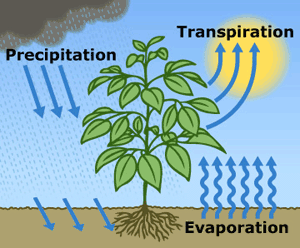Evapotranspiration (ET) the process by which water is transferred from the land to the atmosphere by evaporation from the soil and other surfaces and by transpiration from plants.
Using Evapotranspiration to Determine Watering
To determine how much water your plants need, it’s useful to understand the relationship between plants and climate. Imagine a wet sheet hanging on a clothesline. Sun and wind combine to remove the moisture from the sheet. The hotter the sun and the stronger the wind, the quicker the sheet will dry. Plants go through the same process. The heat from the sun acts as a giant suction pump pulling water from plant leaves. The source water in the soil is pulled up through the roots into the plant body and then to the leaves where it can be used. The water lost from the plant to the atmosphere is called transpiration. The sun’s heat, aided by wind, also dries the soil, causing moisture in the soil to vaporize, or evaporate.
Scientists often combine the term evaporation from a soil surface with transpiration from plants into the concept of evapotranspiration, or commonly ET. It is generally measured in hundredths of inches of water per day. The ability to accurately estimate evapotranspiration rates is key to optimal watering. Optimal watering is defined as applying just the right amount of water to replace the water lost to evapotranspiration. For more information, visit colostate.edu
 Evapotranspiration is the sum of evaporation from the land surface plus transpiration from plants. Precipitation is the source of all water.
Evapotranspiration is the sum of evaporation from the land surface plus transpiration from plants. Precipitation is the source of all water.
® Photo Credit: Salinity Management Guide

